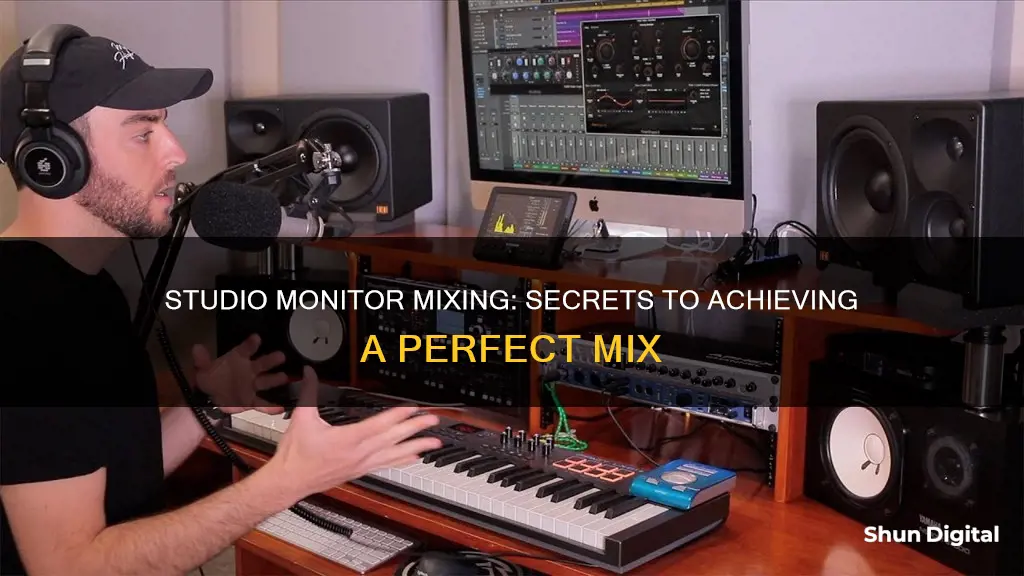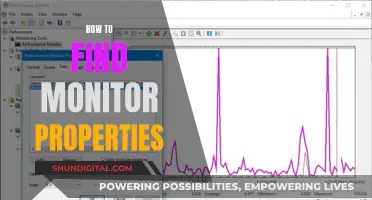
Mixing audio is a complex task that requires a good ear and the right equipment. Studio monitors are an essential tool for any audio engineer, but how do you get the most out of them? In this article, we'll explore some tips and tricks for mixing on studio monitors, including speaker placement, calibration, and how to use multiple monitors effectively. By following these guidelines, you'll be able to create mixes that translate well across different listening environments and sound great no matter where they're played.
| Characteristics | Values |
|---|---|
| Monitor placement | Keep away from corners and walls |
| Monitor orientation | Vertical (upright) or horizontal (laid down on the side) |
| Ear height level | Position the monitors at ear level height |
| Monitor setup | Form an equilateral triangle with the listener |
| Mixing level | 75 dB to 85 dB |
| Secondary reference monitors | Black and white near-field speakers |
What You'll Learn

Calibrating your speakers
Positioning Your Speakers:
The placement of your studio monitors in relation to your ears and the room can significantly impact the sound you hear. It is recommended to position your speakers at ear level, forming an equilateral triangle with your head and the two speakers. This ensures sound reaches both ears simultaneously, eliminating potential phase issues. Make sure to keep the speakers away from corners and walls to avoid sound reflections and phase cancellation issues.
Finding a Calibration Sound Source:
The industry-standard calibration sound source is "Pink Noise," which sounds like static or a waterfall. This type of noise is ideal for calibrating speakers and studio monitors.
Setting Up Pink Noise in Your DAW:
In your DAW (Digital Audio Workstation), create a loop around your "Pink Noise" file by setting the left and right locators. Pull the fader of the "Pink Noise" track down to silence. Turn your speaker volume control all the way down as well, so you can perform the next steps in silence.
Adjusting Volume Levels:
If you are working on popular music genres such as pop, rock, hip-hop, R&B, country, or reggae, adjust the volume of the "Pink Noise" track until the Stereo Buss Out meter reads an average of -14dB RMS. For film score music and orchestral pieces, adjust the volume until the meter reads an average of -20dB RMS to ensure dialogue isn't drowned out.
Calibrating Speakers Individually:
Turn on only your left speaker and adjust its level until the SPL (Sound Pressure Level) meter shows 80dB. Now, turn off the left speaker and repeat the process for the right speaker. Finally, turn on both speakers, and the SPL meter should display approximately 83dB. This sets the optimum volume level for mixing.
Fine-Tuning Speaker Balance:
Sit in the "sweet spot" between your speakers and play pink noise through them. If you perceive the pink noise to be off to one side, adjust the volume of your speakers until the pink noise is centred perfectly between the two speakers.
Marking Your Settings:
Use tape or a marker to mark the volume control knob at the 83dB setting. Additionally, create marks for a louder and a softer setting for quick reference during mixing.
Calibrating a Subwoofer:
If you have a subwoofer, follow the same calibration process as with the main speakers. While the exact placement of the subwoofer is not as critical as the higher-frequency monitors, ensure it is not positioned too close to walls to avoid excessive bass buildup.
By following these steps, you will have accurately calibrated studio monitors, providing you with a reliable listening environment for mixing and producing music.
St Jude Hospital: Performance Monitoring Strategies and Secrets
You may want to see also

Speaker placement
The placement of your studio monitors in relation to your ears and the room can affect the sound you hear. Incorrect monitor placement can cause problems in your mix, with the true sound you hear while working being altered by flaws within your room's acoustics. Here are some tips for optimal speaker placement:
Keep Away from Corners and Walls
If you place your speakers too close to walls, the sound waves will bounce off the walls and reflect back to you, leading to phase cancellation. This can also cause issues in the lower end of the spectrum, especially if your monitors are rear-ported. A minimum distance of 20-30 cm (8-12 inches) between the monitors and walls is generally enough to reduce sound waves reflecting back to your listening position. A maximum distance of 60-90 cm is recommended.
Monitor Orientation
Some monitors have a pre-defined orientation, which is either vertical (upright) or horizontal (laid down on the side). Check the documentation that came with your monitors for the correct placement. High-end models can sometimes be placed in either orientation, allowing you to experiment until you find the optimal position.
The Equilateral Triangle Rule
Position the monitors to form an equilateral triangle with your head. The distance from each monitor to your head should be equal to the distance between the monitors. It is also recommended to place your listening position at a 38% distance from the front wall, avoiding nodal positions at 25% and 50% of the room.
Leave Enough Space to Manoeuvre
Beginners often get caught up in the 'rules' of studio monitor placement and forget to leave enough room in their studio. Musicians in smaller studios may need to bring instruments in and out for each recording session, so ensure you have enough space for your setup.
Position Monitors at Ear Level Height
Position the monitors at the height of your ear level. High-frequency sounds are more directional than lower tones, so to get the full range of high frequencies, the sound should be directed at your ears. Speaker stands can be used to adjust the height of the monitors.
Disconnecting Your Monitor from the Asus Q551L Laptop
You may want to see also

Using multiple monitor setups
Firstly, having two monitors allows you to have one screen for the timeline and another for the mixer view with all the faders, or one for video and the other for scores/tracks. This setup can speed up the process and declutter the screen when working with many plugins, as well as allowing you to tweak little details without losing anything important from sight.
However, it is important to be mindful of the acoustics of your room. If your speakers are too far apart, your centre image may be weak. You can solve this by mounting the speakers above the screens and angling them down, or by stacking your screens instead of putting them side by side.
If you are using two different monitors, you may need to adjust the settings so that they play nicely with each other. For example, you can adjust the resolution and scaling of each monitor so that your windows appear the same size on each. You can also adjust the brightness and colour to make them match as closely as possible.
Finally, if you are using a laptop with an external monitor, you can close the laptop lid and continue to run your programs from the external monitor.
Removing Scratches from Your LCD Monitor: A Step-by-Step Guide
You may want to see also

Choosing the right speakers
When it comes to choosing the right studio monitor speakers, there are several factors to consider. The most important feature of studio monitors is their ability to provide an accurate, uncoloured, and balanced representation of your music. Studio monitors should deliver a flat frequency response, allowing you to hear music as it was recorded without any added enhancements or colouration. This is crucial for mixing and mastering, as you need to make decisions based on the pure, unaltered sound.
Studio Monitors vs Regular Speakers
The key distinction between studio monitors and regular speakers is their neutral and balanced frequency response. Regular speakers, or consumer Hi-Fi speakers, often emphasise certain frequencies to make music sound more lively and pleasing. Studio monitors, on the other hand, offer a flat frequency response, allowing you to hear the true sound of your music. This is essential for mixing, as you need to identify and address any issues in the lower or higher frequencies, which may be masked by the enhanced sound of regular speakers.
Headphones vs Studio Monitors
While headphones can be useful for tracking and identifying small details, they may not be ideal for judging stereo imaging and panning due to the close proximity of the sound source to your ears. Additionally, headphones tend to colour the sound and can provide an unrealistic picture of the stereo space. Mixing on headphones is possible but may be more challenging and time-consuming than using studio monitors. It is important to note that even if you mix on headphones, you will still need a set of speakers to reference your final mix.
Active vs Passive Monitors
When choosing between active and passive studio monitors, it is worth noting that the recording industry predominantly uses passive monitors. Passive monitoring systems require you to match your speakers with a separate amplifier and crossover. Active monitors, on the other hand, have these components built-in, offering convenience and optimal performance as the internal amplifier is specifically matched to the speaker. While a well-designed passive system can deliver excellent results, active studio monitoring systems are more commonly used in professional studios and provide both convenience and performance.
Power Considerations
The power handling of your studio monitoring system will impact not only the volume but also your dynamic range and headroom. Higher wattage systems provide more headroom and allow you to hear more transient details, making precise adjustments to compressors, limiters, and gates easier. Additionally, higher wattage can reduce distortion and prevent clipping during musical peaks.
Driver Types and Configurations
Studio monitors typically have two speakers: a tweeter for high frequencies and a woofer for low and midrange frequencies. Some monitors may also have a third speaker dedicated to low frequencies. The configuration determines how the input signal is divided and sent to each speaker. Bi-amp and tri-amp configurations offer a flatter frequency response and greater definition, as each speaker is individually powered, resulting in more precise reproduction of their dedicated frequency range.
Cabinet Considerations
Studio monitors may have ported or closed cabinets. Ported cabinets help extend the frequency response lower for more bass but may not offer the same precision as closed cabinets. If your studio monitors are placed close to walls or corners, front-ported or closed designs are recommended for more accurate monitoring.
EQ, Room Correction, and Features
Many studio monitors have built-in EQ features to help tune them to your room. Some even offer digital processing to optimise their performance for your acoustic space. While these features can enhance a poorly treated room, they cannot compensate for uncontrolled acoustics. It is crucial to prioritise acoustic treatment to ensure you hear more of your speakers and less of the room's reflections.
Subwoofers
Whether you need a subwoofer depends on the nature of your work. If you are mixing sound for TV or motion pictures, a multi-speaker setup with a subwoofer is essential. However, if your audience is likely to listen to your music on devices like iPods or car stereos, a subwoofer may not provide significant benefits. Additionally, the size of your room should be considered, as smaller rooms may not allow bass frequencies to fully develop, resulting in sonic inaccuracies.
Placement and Isolation
The placement of your studio monitors is crucial for accurate frequency response and a clear stereo image. They should be positioned to form an equilateral triangle with your head when seated in your mix position. Speaker stands are recommended to improve sound quality and reduce sound reflection from the desk or console. Isolation pads are also important to prevent sonic distortions caused by the transmission of energy from the speakers to the surface they are placed on.
Budget and Personal Preferences
When choosing studio monitors, consider your budget and personal preferences. While higher-priced monitors generally offer better quality, it is essential to trust your ears and choose monitors that suit your taste. Additionally, consider the size of your room, the intended use, the genres you work with, and the specific features that align with your mixing needs.
In summary, studio monitors are a crucial investment for any home or project studio. By prioritising accuracy, treating your room adequately, and choosing monitors that suit your space and preferences, you will be well on your way to achieving mixes that translate well across different listening environments.
Freesync Monitor Buying Guide: Is It Worth It?
You may want to see also

Using headphones alongside studio monitors
Using headphones and studio monitors together while mixing can help produce audio that translates well across different listening environments. Here are some tips for using headphones alongside studio monitors:
Audition your mixes in both headphones and monitors
As a producer, be aware that your audience will listen to your tracks in various environments, some of which may be less than ideal. It is essential to audition your headphone mixes in different listening environments by referencing your tracks on various monitors and systems. This will help you understand how your audio behaves in different settings and make better mixing decisions. For example, your perfect headphone mix might sound unfamiliar when played over a PA system, or vocals might get drowned out due to room acoustics and reflections altering the characteristics of your music.
Choose headphones with a flat frequency response
Different headphone models offer unique frequency responses that can "colour" the audio, affecting how you perceive your tracks. To make objective mixing choices, choose headphones with a flat frequency response to provide a neutral portrait of your audio. This will prevent you from making unnecessary adjustments to your mix due to the colouring effect of your headphones.
Use multiple pairs of headphones for monitoring
Mixing engineers are increasingly ensuring excellent translation across various headsets. Using multiple pairs of headphones, from top-quality studio headphones to low-grade earbuds, helps you understand the sonic differences and make sure your track sounds excellent, regardless of the listening device.
Take advantage of headphones for detailed listening
Headphones can be beneficial for detailed listening when mixing at low volumes. They can help you pick up on tiny details, phasing issues, and stereo placement. Additionally, open-back headphones allow sound to leak to each ear, providing a more natural listening experience.
Consider the advantages of both
Studio monitors and headphones each have their advantages. Studio monitors offer a flatter frequency response, eliminate ear fatigue, and provide a more natural listening experience. On the other hand, headphones allow for detailed listening, are suitable for quiet environments, and can help identify phasing issues. Combining the strengths of both can lead to more effective mixing.
Connecting Pioneer Receiver to Monitor: Easy Steps
You may want to see also
Frequently asked questions
To set up your studio monitor speakers, you should:
- Position your speakers at the same height as your ears, facing directly at you.
- Ensure your speakers are far apart from each other as they are from you, forming an equilateral triangle.
- Calibrate your speakers using an SPL (sound pressure level) app and "Pink Noise" (static or waterfall-like sound) as the calibration sound source.
- Calibrate your speakers individually, adjusting the volume until the SPL meter shows 80dB for each speaker.
- Mark your settings using tape or a marker on your volume control knob.
To mix on studio monitors, you should:
- Listen to reference material you're familiar with through your monitors in your room.
- Listen to your mixes on multiple speakers and in different environments to understand how your audio behaves in different setups.
- Break in your monitors by playing music through them at moderate levels for around 20 hours, allowing the transducers to stabilise.
- Choose a mixing level between 75 dB and 85 dB to avoid ear fatigue and hearing damage.
- Consider using both headphones and monitors while mixing to produce audio that translates well across different listening environments.
Some common mistakes to avoid when mixing on studio monitors include:
- Placing monitors too close to corners or walls, which can cause sound waves to bounce off and lead to phase cancellation.
- Incorrect monitor orientation, which can affect the sound you hear.
- Poor room acoustics, such as untreated rooms or reflective surfaces, can impact the sound quality and your decision-making during mixing.







